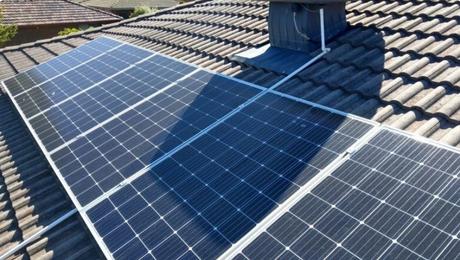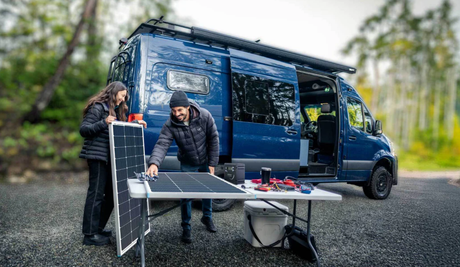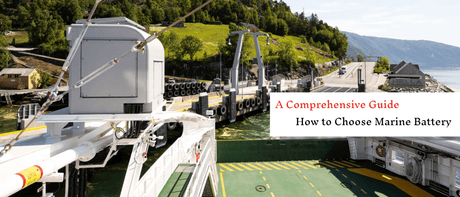When thinking of switching to solar power, you'll find there's plenty of research to be done before choosing your system parts and components. For example, one purchase you may be considering is an MPPT charge controller. If you're unsure what an MPPT charge controller is, whether you need one, or what size you need, read on to learn about this solar device.
When you're new to solar energy, it can be a confusing place. Many components make up an optimized solar power setup, and if you're not experienced with electrical terms, it can seem overwhelming. So many questions come up when researching your ideal solar system. Like what is a solar charge controller? And what's an MPPT?
A charge controller, also known as a solar controller, is a feature for a battery charger that regulates the voltage and current flowing from your solar panels to your solar batteries.
Before doing further research, you should know if you want to build a grid-tied solar system, utilize storage for off-grid living, or have a hybrid solar power system utilizing both the grid and batteries. If you're going to live off-grid or use solar storage (batteries), you will always need a charge controller.
An MPPT charge controller is a popular type of charge controller because it can optimize your system and improve your solar panels efficiency. This article will help guide and educate you on why you might want an MPPT in your system and how to find the right one.
What is a charge controller?
The solar charge controller sits between your solar panels and solar batteries. Charge controllers help prevent your solar batteries from getting overcharged; they do so by limiting the amount of charge and rate of charge that flows to your batteries. Charge controllers also prevent battery drainage, and shut down the system if the stored energy falls below 50% capacity, to charge the batteries at the correct voltage level. The charge controller is an essential part of a battery-connected solar panel system that helps preserve the life and health of your solar batteries.
What is an MPPT charge controller?
MPPT stands for Maximum Power Point Tracking charge controller. Even if you've heard of an MPPT before, most of us have no idea what an MPPT charge controller actually does. In simple terms, an MPPT charge controller is used to monitor a solar PV array, but how it does, gets a bit more technical.
An MPPT charge controller is a solar component that optimizes the connection between solar panels and either a solar battery or the utility grid. The maximum power point describes the ideal point on an IV curve where voltage and current multiply to provide maximum power. The maximum capacity is the most that the given photovoltaic (PV) system can produce at any given moment.
An MPPT is sometimes called a power point tracker for short, but it is not to be confused with solar panel trackers. Solar panel trackers are a type of solar panel mount that physically moves to follow or track the sun. An MPPT charge controller is a control feature for a battery charger.
What does an MPPT charge controller do?
An MPPT charge controller works to quickly charge a solar battery to ensure that the loads receive maximum current to be used. If that still doesn't make sense, you're not alone; the function of an MPPT can be confusing if you're new to solar power and electricity.
To explain it simply, the function of an MPPT charge controller is similar to that of the transmission in your car. In a car, you'll find that when the transmission is in the wrong gear, the car's wheels don't receive maximum power. This happens because the car's engine is running either faster or slower than its ideal speed range. A transmission's purpose is to align the engine to the wheels to run in an ideal speed range even when the driver is varying acceleration or driving on uneven terrain.
The ideal voltage in a car is comparable to the peak power voltage from a solar power system. Peak power voltage will vary throughout the day depending on sunlight intensity and solar cell temperature. As the peak power voltage of a PV array varies throughout the day, an MPPT charge controller "tracks" the variance and adjusts the ratio between the voltage and current accordingly to deliver maximum power to the battery. Thus it gets the name Maximum Power Point Tracker - MPPT.
Is an MPPT charge controller worth it?
There are many benefits to using an MPPT charge controller. There are other charge controller options available such as the shunt controller or pulse width modulation (PWM) technologies. Using one of these non-MPPT charge controllers means you're essentially just connecting the battery directly to the solar module. But when you use maximum power point tracking, you'll benefit from more efficient DC-DC converter technology compared to other options.
A non MPPT, and usually cheaper, charge controller will charge your battery with the voltage dictated by the battery. The voltage of a fully-charged solar battery is higher than that of a discharged battery. Therefore, the amount of solar power drawn by an empty battery is usually lower than that of a full battery.
By comparison, the MPPT charge controller will utilize whole module power and dictate the voltage of the battery charging state. The MPPT charge controller will keep the current and voltage at optimized levels where the modules deliver the most energy.
What is better, MPPT or PWM?
Different controller options are available on the market, and you may notice that PWM charge controllers are less expensive than an MPPT.
You almost always need a charge controller in a solar system that utilizes battery storage. The exception is thay you don't need a charge controller if you only have small 1 to 5-watt panels. But if a solar panel puts anything beyond 2 watts for each 50 battery amp-hours, then you will need a charge controller. So what's the difference between controller types, and is it worth paying more for an MPPT?
There are two main types of charge controllers on the solar market:
- PWM (pulse width modulation)
- MPPT (maximum power point tracking)
Both of these charge controller options are DC to DC converters that take the voltage output from your solar panels and convert it to the voltage, which can charge a solar battery bank. Here's how the two options stack up:
- Typically older technology
- Often cheaper
- Simpler and meant for smaller systems
- Newer technology
- More efficient
- Offer greater flexibility of design
- Can be built for larger systems
- Typically more expensive
- Offer longer warranties from the manufacturer
There are certainly differences in cost between these two charge controllers, but the main difference is that MPPT charge controllers are more efficient because they allow the photovoltaic array (PV array) to generate voltage that's higher than that of the battery without losing power.
By comparison, the typical PWM charge controller on the market can only regulate the output voltage of a PV array, but it can't regulate the current. The enhanced ability of an MPPT is essential for larger PV systems, and it allows for more flexibility in both system design and performance.
A PWM charge controller maintains around the same electrical current as your PV array. That means the output power will be reduced. An MPPT charge controller is a superior option because it will monitor your PV array to determine the maximum power point and then use this information to regulate both the output voltage of the PV array and also the current. This means an MPPT charge controller will lower the voltage and increase the current at the same time - all while maintaining the overall output power.
Why is MPPT more expensive than PWM?
Almost all solar controllers will use Pulse Width Modulation (PWM) to vary the voltage produced by a panel during the various stages of battery charging (Float, Bulk Charge, Trickle, Absorption, etc.). But Maximum Power Point Tracking (MPPT) chargers add additional logic (and therefore expense) to hold the battery at its ideal current (IMP) and the solar module close to its ideal voltage (VMP).
An MPPT charge controller costs more because it allows a wider range of modules and temperature/irradiance to charge a particular battery voltage. In short, it is a more advanced feature that makes your solar system more efficient than PWM options.
What size MPPT do I need?
When it comes to sizing charge controllers, you must first make a decision on whether you're going to use a PWM or MPPT controller. Getting your solar charge controller correctly sized is an essential step to safely operate your solar power system. The size of your charge controller is dependent on the type of charge controller you have; in this case, we'll look at sizing MPPT Charge Controllers.
Once you've decided to get an MPPT charge controller, your next question will be, what size do I need? Choosing the right MPPT charge controller size requires a few calculations, but it is important you choose the right size. Selecting the wrong charge controller can result in up to a 50% loss of generated power.
An MPPT charge controller limits output, so theoretically, you could make your solar power system as large as you want, and the MPPT charge controller will limit the array's output current to the maximum limit. But, if your solar array is too large, then the solar power may end up being wasted because the MPPT charge controller will always limit the output. Therefore, it's recommended that you limit your solar array to between 110%-125% of the maximum controller rating.
To choose the right controller size, take the number of solar panels and multiply it by watts to determine the total watts of the solar array. Then, divide the total watts by the voltage of your solar battery bank to determine amps. Lastly, add 25% to allow for cold temperatures and round up. Note that solar charge controllers are always rated and sized by the solar panel array current and system voltage.
For a smaller solar system, you can run calculations yourself to determine the right size. But things can get complicated if you have a larger solar panel system. If you're not confident sizing your charge controller, ask your solar contractor to consult our solar panel calculators or contact our team for professional advice.
As a first step, we recommend using our Renogy solar panel calculator. This will help you size both your solar panels and charge controller, along with all of the other components in your system.
👉To help you get started, we're celebrating Labor Day with a special sale on all our products, including batteries, inverter, and solar panel kits! Hurry, this offer is for a limited time only!
Conclusion
If you want to utilize solar storage, then a charge controller will be an essential part of your solar power system. Whether you want to live in an off-grid cabin, tiny house, or RV, charge controllers are going to be an essential part of your solar installation.
Doing the research on controller types and weighing your different options will ensure you select the best solar charge controller in the right size to create a highly efficient solar power system.










